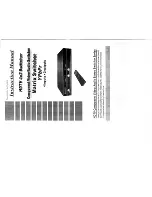
DES-3226S Layer 2 Fast Ethernet Switch User’s Guide
27
•
Topology Change A Topology Change trap is sent by the Switch when any of its configured ports transitions from
the Learning state to the Forwarding state, or from the Forwarding state to the Blocking state. The trap is not sent if a
new root trap is sent for the same transition.
•
Link Change Event This trap is sent whenever the link of a port changes from link up to link down or from link down
to link up.
•
Port Partition This trap is sent whenever the port state enters the partition mode (or automatic partitioning, port
disable) when more than thirty-two collisions occur while transmitting at 10Mbps or more than sixty-four collisions
occur while transmitting at 100Mbps.
•
Broadcast\Multicast Storm This trap is sent whenever the port reaches the threshold (in packets per second) set
globally for the Switch. Counters are maintained for each port, and separate counters are maintained for broadcast
and multicast packets. The Switch’s default setting is 128 kpps for both broadcast and multicast packets.
MIBs
Management and counter information are stored in the Switch in the Management Information Base (MIB). The Switch uses
the standard MIB-II Management Information Base module. Consequently, values for MIB objects can be retrieved from any
SNMP-based network management software. In addition to the standard MIB-II, the Switch also supports its own proprietary
enterprise MIB as an extended Management Information Base. These MIBs may also be retrieved by specifying the MIB’s
Object-Identifier (OID) at the network manager. MIB values can be either read-only or read-write.
Read-only MIBs variables can be either constants that are programmed into the Switch, or variables that change while the
Switch is in operation. Examples of read-only constants are the number of port and type of ports. Examples of read-only
variables are the statistics counters such as the number of errors that have occurred, or how many kilobytes of data have been
received and forwarded through a port.
Read-write MIBs are variables usually related to user-customized configurations. Examples of these are the Switch’s IP
Address, Spanning Tree Algorithm parameters, and port status.
If you use a third-party vendors’ SNMP software to manage the Switch, a diskette listing the Switch’s propriety enterprise
MIBs can be obtained by request. If your software provides functions to browse or modify MIBs, you can also get the MIB
values and change them (if the MIBs’ attributes permit the write operation). This process however can be quite involved, since
you must know the MIB OIDs and retrieve them one by one.
Forwarding and Filtering
The Switch enters the relationship between destination MAC or IP addresses and the Ethernet port or gateway router the
destination resides on into its forwarding table. This information is then used to forward packets. This reduces the traffic
congestion on the network, because packets, instead of being transmitted to all ports, are transmitted to the destination port
only. Example: if Port 1 receives a packet destined for a station on Port 2, the Switch transmits that packet through Port 2
only, and transmits nothing through the other ports. This process is referred to as ‘learning’ the network topology.
MAC Address Aging Time
The Aging Time affects the learning process of the Switch. Dynamic forwarding table entries, which are made up of the
source MAC addresses and their associated port numbers, are deleted from the table if they are not accessed within the aging
time.
The aging time can be from 10 to 1,000,000 seconds with a default value of 300 seconds. A very long aging time can result in
dynamic forwarding table entries that are out-of-date or no longer exist. This may cause incorrect packet forwarding decisions
by the Switch.
If the Aging Time is too short however, many entries may be aged out too soon. This will result in a high percentage of
received packets whose source addresses cannot be found in the forwarding table, in which case the Switch will broadcast the
packet to all ports, negating many of the benefits of having a Switch.
Static forwarding entries are not affected by the aging time.
Filtering and Access Profile Masking
The DES-3226S Switch can use a form of manually configured packet filtering to segment the network and control
communication between segments. It can also filter packets off the network for intrusion control. Filtering is done by setting up
an Access Profile Mask.
The access profile mask uses information contained in packet headers to determine whether the packet is forwarded or filtered
(i.e. dropped). The forwarding decision is made first by examining header information; looking at the VLAN or MAC address.
Содержание DES-3226S
Страница 126: ......
















































